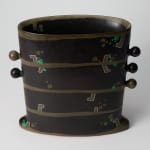Morino Taimei 森野泰明 b. 1934
H22.6 x W24.8 x D9cm
With Signed Wood Box
Further images
-
(View a larger image of thumbnail 1
)

-
(View a larger image of thumbnail 2
)

-
(View a larger image of thumbnail 3
)

-
(View a larger image of thumbnail 4
)

-
(View a larger image of thumbnail 5
)

-
(View a larger image of thumbnail 6
)

-
(View a larger image of thumbnail 7
)

-
(View a larger image of thumbnail 8
)

-
(View a larger image of thumbnail 9
)

-
(View a larger image of thumbnail 10
)

-
(View a larger image of thumbnail 11
)

-
(View a larger image of thumbnail 12
)

-
(View a larger image of thumbnail 13
)

-
(View a larger image of thumbnail 14
)

-
(View a larger image of thumbnail 15
)

-
(View a larger image of thumbnail 16
)

-
(View a larger image of thumbnail 17
)

Kyoto-born Morino Taimei 森野泰明 (b. 1934)’s repertoire consists of colourful, polychrome geometric motifs that translate traditional Kyoto glaze methods into contemporary mediums. Influenced by American Pop Art and Abstract Expressionism in the 1960s, his work follows the tenets of rejecting traditional folk-craft forms observed by the avant-garde group Sodeisha. His works have been collected extensively in museum collections, such as that of the Metropolitan Museum of Art, The Victoria and Albert Museum, Seoul Metropolitan Museum of Art, Musee des Decoratifs and many others.
Director's commentary: This masterpiece by Morino Taimei illustrates the artist's ultimate pursuit of modern art in the clay medium. Morino treats the clay as a canvas; treating the central green rectangular surface as a pillar which anchors the piece, the glaze treatment by the painter further builds up the canvas, the small opening in the middle breaks the tension on the whole canvas. The artist hopes that viewers read between the lines, shapes, and dots that playfully stretch across the surface as one would read a piece of literature or poetry. Morino's work is firmly rooted in the traditions of his native Kyoto, yet his exposure to international art trends during the four years he spent teaching at the University of Chicago in the 1960s and his awareness of more avant-garde Japanese practices both affected his work.
















